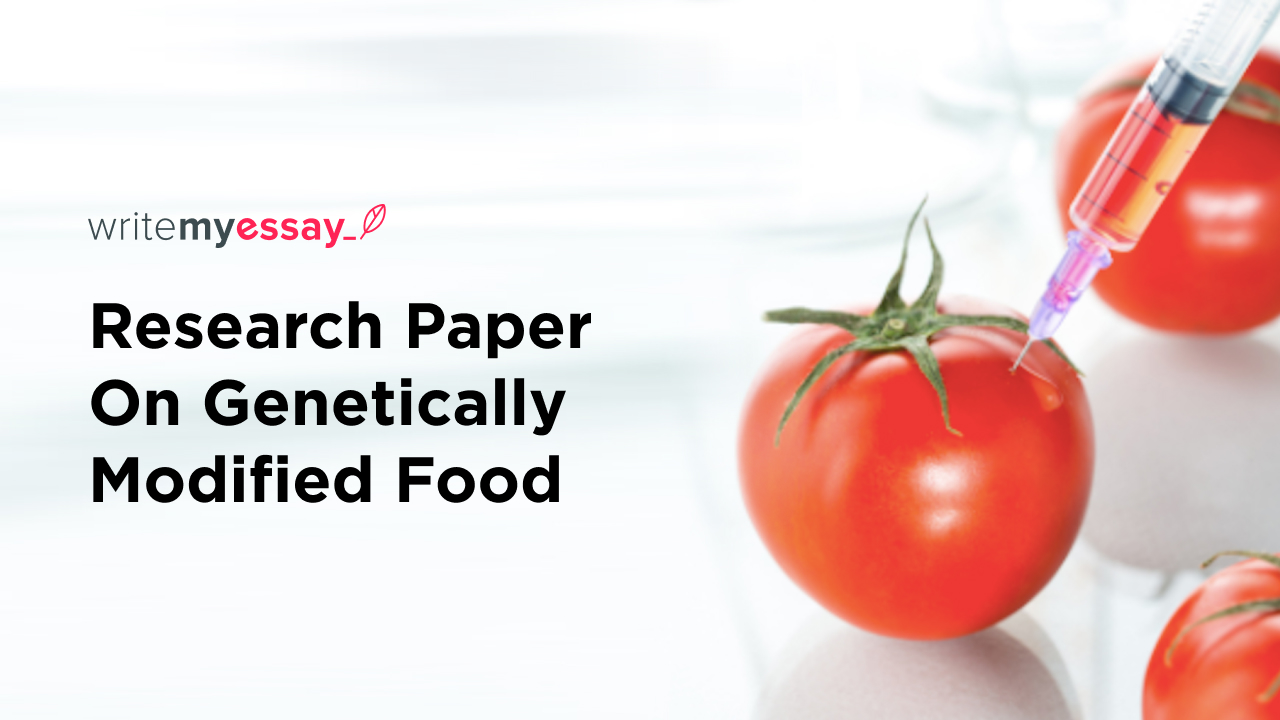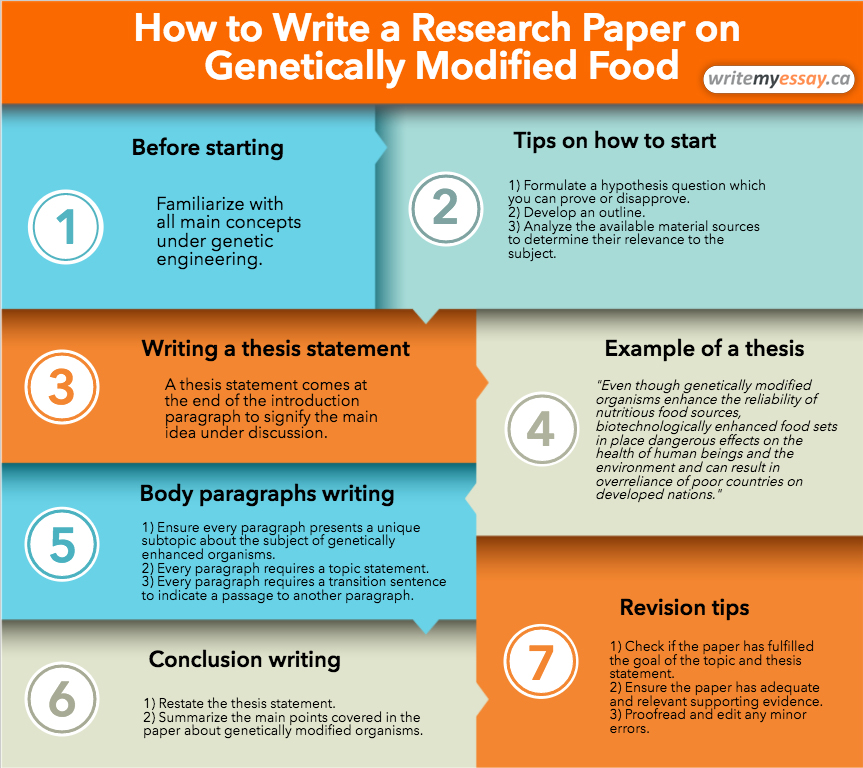
Research Paper On Genetically Modified Food

Table of Contents
How To Write a Good Research Paper On Genetically Modified Food
- How to start a research paper on genetically modified food
- Tips on how to start
- Example of an outline
- Example of a thesis
- Example of an introduction
- How to write body paragraphs: Tips on body writing
- Example of the first body paragraph
- Example of the second body paragraph
- Example of the third body paragraph
- How to finish a research paper: Tips on conclusion writing
- Example of a conclusion
- Tips on research paper revision

How to start a research paper on genetically modified food
A research paper on genetically modified food requires one to understand the subject clearly because it involves scientific concepts and terms. Before starting the paper, a writer should familiarize with all concepts of genetic engineering. Consequently, the paper will have strong command and evidence of a writer who understands the subject. Therefore, the author should search for good and relevant material to source the necessary information.
Tips on how to start
Tips on how to start a research paper on genetically modified food can assist the writer to develop an interesting paper. The first step is to choose a topic since a lot of information exists about genetically modified organisms. The topic should be specific for more focused research. Another crucial tip is to establish the methodology of analyzing different sources of information for use in the paper. In addition, the writer should formulate a hypothesis question that they can prove or disapprove of. The next important tip is to develop an outline of the paper which gives guidance when writing. The researcher can then analyze the available material sources to determine their relevance to the subject. Thereafter, the writer should formulate an outline to give the general structure of the entire research paper.
Example of an outline
- Introduction: Presentation of the topic and its significance. Roadmap for next chapters.
- Literature review: Information from other relevant sources on Genetically Modified Organisms
- The methodology: Description of activities carried out during the research
- Results: Presentation and interpretation of findings
- Conclusion: Summary of main points and how to further the study.
Example of a thesis
The thesis statement comes at the end of the introduction paragraph to signify the main idea under discussion. An example of a thesis statement for a research paper on genetically modified food is: “Even though genetically modified organisms enhance the reliability of nutritious food sources, biotechnologically enhanced food sets in place dangerous effects on the health of human beings and the environment and can result in overreliance of poor countries on developed nations.”
Generally, the introduction should be brief and establish the foundation of the subsequent chapters
Example of an introduction
Genetic modification of organisms is a modern method of reproducing animals and plants in the laboratory through changing of genes. Genetically enhanced organisms form part of our lives as food and plants. Examples of foods include corn, beans, and dairy products. The enhanced foods have the advantages of fast growth, high nutrition, tolerance against adverse conditions of weather, resistance to pests and diseases, and conserved water and soil. However, there is a danger to human health and the environment in general since scientists do not care about the genes applied in breeding new organisms. The topic of genetically enhanced organisms is very controversial since some people discuss it based on the benefits while others focus on the disadvantages.
How to write body paragraphs: Tips on body writing
The body of the research paper gives the main discussion of the subject. Therefore, the body paragraphs should be well structured each discussing a specific idea. Some tips can be of help for one to prepare interesting body paragraphs. The first tip is to ensure every paragraph presents a unique subtopic about the subject of genetically enhanced organisms. The writer should have a topic statement for every paragraph. The statement guides the discussion under the specific paragraph. The author should present evidence that gives meaning to the topic statement through citations of other sources. Every paragraph requires a transition sentence to indicate a passage to another paragraph.
Example of the first body paragraph
Genetic characteristics of an organism are replaced or enhanced with better ones during the process of biotechnological modification. For instance, if a corn plant possesses genes that make it prone to pests and diseases, biotechnology scientists can change the gene and replace it with one that is pest resistant. Some individuals refer to this as tampering with the genes of organisms and hence disagree with concepts of genetic engineering. However, there are various benefits associated with GMOs. According to Eli Lilly (2007), the first genetically enhanced organism was the E. coli bacterium that was discovered in 1982. The product led to the development of human insulin. Lilly (2007) notes that a tobacco plant was the first ever genetically enhance plant in the year 1983. According to Hensley (2008), the first genetically modified animal developed for the purposes of consumption was salmon. However, it has not been approved for consumption due to resentment from the conservationists.
Example of the second body paragraph
The topic of consumption of enhanced foods has spurred discussions in some continents such as Africa, Australia, Europe, and America. Some countries such as Australia have introduced policies that require companies to label if their food products are genetically enhanced. Other regions such as America have not implemented such policies but discussions are in progress. Besides, the discussion in other regions like African countries is whether genetically modified foods are safe and good for agriculture. The debate about genetically modified organisms is therefore varied depending on the region and culture of the people.
Example of the third body paragraph
Genetically enhanced organisms have various negative impacts on both human health and the environment. For instance, there are increased cases of weed resistance to chemicals that are meant to control them. The increase in the variety of herbicides poses a great danger to the environment and human beings who can consume them through the food chain (Graham Brookes & Peter Barfoot, 2012). In addition, a high increase in the number of genetically modified organisms poses a threat to the existence of the natural ecosystem. The ecosystem has a natural maximum capacity for the population of organisms to accommodate. Any imbalance will disturb the capacity hence a threat to the environment.
How to finish a research paper: Tips on conclusion writing
One can finish the research paper by creating a connection between the body paragraphs and what they intend to conclude. The conclusion then summarizes the paper emphasizing on main points. There are various tips on how to conclude a research paper on genetically modified food. One idea of the conclusion is to restate the thesis statement of the research paper in a rephrased manner. Another tip is to summarize the main points covered in the paper about genetically modified organisms. In addition, one can conclude by making a call to action about the controversial topic of GMOs. To make the conclusion effective, one should stick to basic information on the subject rather than introducing complex issues. Finally, since the topic of genetically modified food has varied opposing opinions, one should present a logical opinion based on the evidence.
Example of a conclusion
Over the last three decades, biotechnology in the field of genetic engineering has resulted in numerous advantages to human beings like the introduction of insulin for humans and also genetically enhanced food. There is great potential to invent more beneficial products because of genetic engineering. The demand for supplying food has become easier due to the scientists’ innovative work. Therefore, genetically enhanced foods should not be avoided or feared since there is evidence of safety and many benefits. However, the companies producing the foods should develop policies to monitor and regulate the possibility of making dangerous products to human health and the environment. The companies should also indicate any possible side effects associated with the consumption of the foods for the sake of informing the public.
Tips on research paper revision
The writer of a research paper on GMOs should prepare very effective work to communicate a clear message. Consequently, revision of the paper is a crucial element that every writer needs to consider. The first tip for revising is to check if the paper has fulfilled the goal of the topic and thesis statement. The writer should also confirm if they have applied appropriate concepts in the argument about genetically modified organisms. In addition, the writer should ensure the paper has adequate and relevant supporting evidence that backs up the discussion. Another important tip is to check the organization of the paper. The organization should follow the guidelines of a research paper and retain the structure of the outline. The writer should then proofread and edit any minor errors such as spelling, grammar, and sentence structure. The best way to polish all errors is to share the paper with another person whether a peer or an expert who can help to edit minor errors.
Concluding Remarks
Genetically modified food is a controversial topic. There is no denying that GMOs have played a great role in improving yields in the modern world. Because of this, we have been able to stave off mass starvation and hunger. However, there are drawbacks to the idea of artificially enhancing the production of crops. While writing a research paper, students need to make sure that the data they base their research on is accurate and supported by academia. WriteMyEssay offers well-researched papers on all topics. Our writers have ample experience in dealing with the nuances of the issues. So, what are you waiting for?


